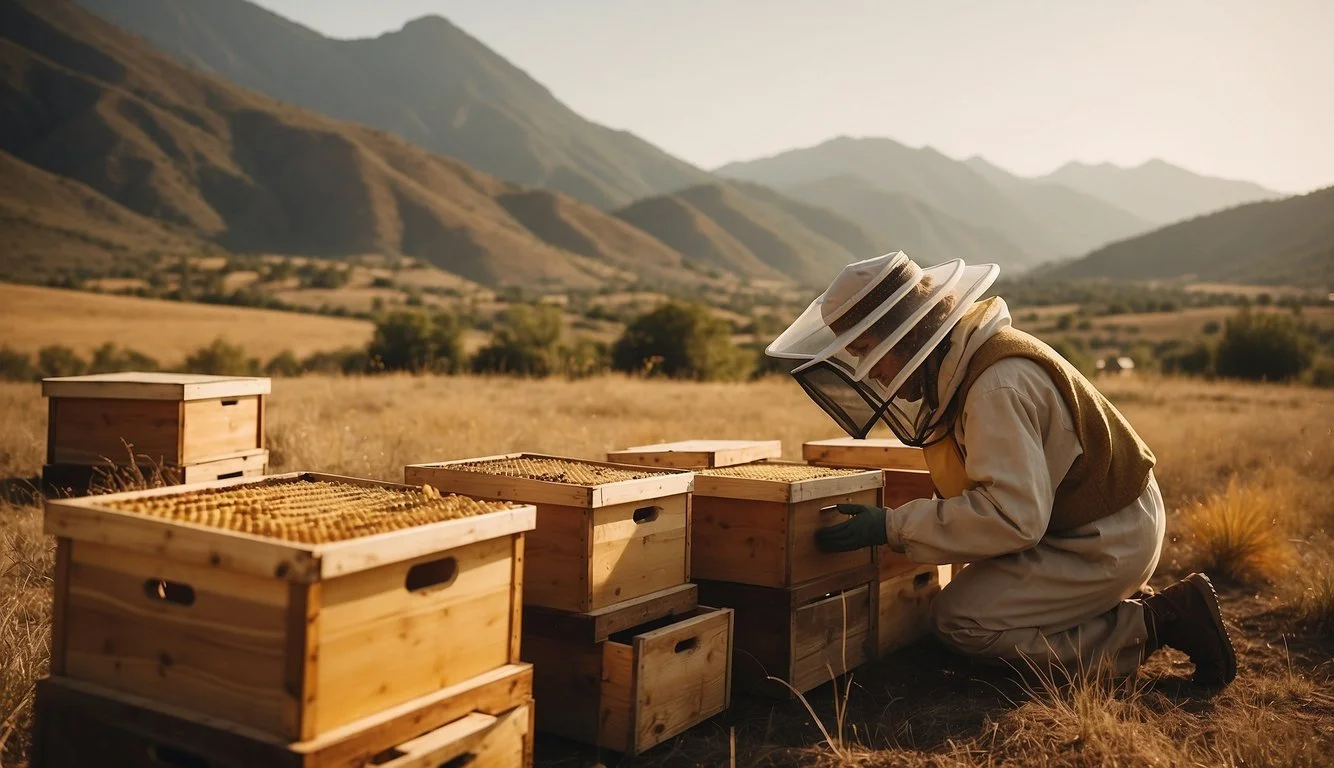Documentary Review: Honeyland (2019)
A Cinematic Masterpiece
Documentary Review: Honeyland (2019)
Set against the stunning backdrop of Macedonia's rugged mountains, "Honeyland" follows Hatidze Muratova, one of the last wild beekeepers in Europe. The film offers a meticulous and poignant look at her life, capturing the delicate balance between humanity and nature. The directors, Tamara Kotevska and Ljubomir Stefanov, have crafted a deeply moving narrative that explores themes of sustainability, tradition, and resilience.
What distinguishes "Honeyland" from other nature documentaries is its intensely personal focus on Hatidze's solitary yet vibrant world. Her practices and interactions with the bees highlight a disappearing way of life, making the documentary both a visual and emotional experience. Viewers are drawn into her intimate connection with the environment, providing a window into the broader ecological and social changes occurring in the region.
The quiet beauty of "Honeyland" lies in its observational style, allowing the story to unfold naturally without intrusive commentary. This approach not only honors Hatidze's journey but also emphasizes the universal themes of harmony and coexistence. Through its lens, the film serves as a compelling reminder of the vital relationship between humans and the environment.
Overview of 'Honeyland'
"Honeyland" is a 2019 documentary that captures the life of a rural beekeeper in Macedonia, focusing on her symbiotic relationship with nature and her struggles. It explores her unique way of life and interactions with outsiders.
Production Background
"Honeyland" was directed by Ljubomir Stefanov and Tamara Kotevska. The project initially served as an environmental documentary but shifted focus when the filmmakers discovered Hatidze Muratova, the central figure. It took three years to complete, with the team capturing over 400 hours of footage. The production involved a small crew and intimate filming techniques to maintain authenticity and convey Hatidze's story as naturally as possible.
Synopsis
The film follows Hatidze Muratova, a beekeeper in the remote mountains of Macedonia. Her sustainable practice of harvesting honey—taking only half and leaving the rest for the bees—illustrates a delicate balance with nature. The narrative intensifies when a nomadic family moves nearby, disrupting this balance by overharvesting. The documentary showcases the impact of their actions on Hatidze’s livelihood and the ecosystem. Through vivid storytelling and compelling cinematography, "Honeyland" highlights themes of environmental responsibility, resilience, and tradition.
Principal Characters
Hatidze Muratova is the principal character, known for her dedication to beekeeping and her motto, "one half for me, one half for you." She lives with her ailing mother in a village devoid of modern amenities.
The nomadic family, led by Hussein Sam and his wife, plays a crucial role. Their arrival introduces conflict as their beekeeping practices clash with Hatidze's sustainable methods.
Each character's interactions and decisions underscore the documentary’s themes, providing a vivid depiction of rural life and ecological challenges.
Review and Analysis
In "Honeyland," striking cinematography blends with a compelling narrative structure to explore themes of sustainability, tradition, and human impact on nature. The directors' vision is evident throughout, creating a deeply personal yet universal story.
Cinematography
"Honeyland" is visually stunning, capturing the rugged beauty of the Macedonian landscape. The filmmakers utilize natural light, framing their shots to emphasize the isolation yet resilience of the protagonist, Hatidze. Close-ups capture her interactions with the bees, adding an intimate layer to the story.
The contrast between the serenity of nature and the harshness of human actions is highlighted through sweeping aerial views and tight, focused shots. This visual juxtaposition reinforces the documentary's central themes, making the cinematography a crucial element in the storytelling.
Narrative Structure
The documentary follows a linear narrative, focusing on Hatidze's life as a traditional beekeeper. The plot unfolds gradually, revealing her day-to-day struggles and interactions with her bees and her ailing mother. This slow build-up creates a strong emotional connection with the audience.
The arrival of new neighbors introduces conflict, driving the narrative forward. Their contrasting methods of beekeeping and disregard for ecological balance serve as a critical turning point. The filmmakers skillfully weave this human drama with broader environmental issues, maintaining a coherent and engaging storyline.
Thematic Exploration
"Honeyland" delves deeply into themes of sustainability and tradition. Hatidze’s harmonious relationship with nature contrasts sharply with her neighbors' exploitative practices, highlighting the dire consequences of unsustainable behavior. The film also addresses themes of isolation and community.
Hatidze, though solitary, embodies resilience and dedication to her craft. Her interactions with her neighbors showcase the tension between old and new ways of life. The filmmakers use these themes to provoke thought about broader issues of environmental and cultural sustainability.
Directorial Vision
Directors Tamara Kotevska and Ljubomir Stefanov demonstrate a clear vision throughout the film. Their unobtrusive, observational style allows the story to unfold organically, providing an authentic glimpse into Hatidze’s life.
They balance poetic visual storytelling with unflinching realism, highlighting both the beauty and brutality of her world. The directors’ commitment to authenticity is evident in their choice to omit voiceover narration and minimalistic use of music, allowing the natural sounds and dialogues to immerse the audience fully.
Cultural and Social Impact
The film "Honeyland" sheds light on significant environmental and societal issues. It highlights the delicate balance of ecosystems and the struggles faced by individuals living in isolation.
Environmental Messages
"Honeyland" focuses on the intricate relationship between humans and nature. The protagonist, Hatidze Muratova, demonstrates sustainable beekeeping practices in the rugged landscape of Macedonia.
Her methods collaborate with the natural environment, ensuring resources are conserved for future generations. The film contrasts her traditional approach with her neighbors' exploitative methods, spotlighting the dire consequences of unsustainable practices.
This juxtaposition underscores the critical need for environmental stewardship. "Honeyland" makes a compelling case for preserving traditional wisdom and sustainable living as vital parts of maintaining ecological health.
Societal Commentary
The documentary also offers a profound look at societal issues. Hatidze's isolated life with her elderly mother highlights the challenges of rural living and the social dynamics within these communities.
It reveals how modernization and economic pressures disrupt traditional ways of life. The arrival of new beekeepers represents external influences that bring both opportunity and conflict.
"Honeyland" illustrates the resilience and adaptation required to navigate these changes, providing a nuanced view of rural society's complexities. The film compels viewers to consider how these shifts impact individuals and communities alike.
Reception
Honeyland has been met with significant critical acclaim, garnered numerous awards and nominations, and elicited a strong response from audiences worldwide. The film's unique approach to storytelling and its poignant thematic elements have earned it a special place in documentary cinema.
Critical Acclaim
Critics have widely praised Honeyland for its breathtaking cinematography and intimate portrayal of its protagonist, Hatidze. Publications such as Roger Ebert's film review and The Atlantic highlighted its quiet intensity and the director's ability to capture the essence of a fading way of life. Reviewers have noted the film as both deeply personal and universally resonant, making it a standout in the documentary genre.
Awards and Nominations
Honeyland has received an impressive array of awards and nominations. It made history at the Academy Awards with nominations for both Best Documentary Feature and Best International Feature Film. The film also won several prestigious prizes, including the Grand Jury Prize at the Sundance Film Festival. These accolades underscore its powerful storytelling and unique impact.
Audience Response
Audiences have also responded strongly to Honeyland, with many expressing admiration for Hatidze's resilience and the film's stunning visuals. Viewer reviews often cite the emotional depth and the intimate glimpse into a vanishing way of life as key elements that leave a lasting impression. The film's ability to connect with viewers on a personal level has contributed significantly to its success.
Comparative Analysis
"Honeyland" distinguishes itself in the realm of documentaries with its focus on a solitary beekeeper in rural Macedonia, delivering both an intimate portrait and a broader environmental message. Examining similar documentaries and contrasting them with fictional films provides deeper insights into its unique value and approach.
Similar Documentaries
"Honeyland" shares thematic similarities with documentaries such as "The Biggest Little Farm" and "Virunga." These documentaries also explore the intricate bond between humans and nature.
In "The Biggest Little Farm," the emphasis is on sustainable farming and the revitalization of an entire ecosystem, echoing "Honeyland’s" themes of ecological balance and human-nature coexistence.
"Virunga," on the other hand, highlights the clash between conservation efforts and commercial interests, a conflict subtly reflected in "Honeyland" through Hatidze’s interactions with neighboring beekeepers who prioritize profit over sustainability.
By comparing these films, viewers can appreciate "Honeyland's" unique approach to portraying environmental issues through deeply personal storytelling.
Contrast with Fictional Films
When comparing "Honeyland" to fictional films, several key differences stand out, particularly in narrative structure and emotional engagement. Fictional films often rely on scripted dialogue and predetermined plotlines to drive their stories.
In contrast, "Honeyland" captures unscripted moments of vulnerability and resilience, offering a raw authenticity that fictional films might lack.
The character development in "Honeyland" emerges organically as viewers witness Hatidze's daily struggles and triumphs, as opposed to the constructed character arcs typical in fictional films.
Moreover, the visual storytelling in "Honeyland" is more observational, focusing on real-life scenarios rather than elaborately staged scenes, creating a connection to the natural world that feels immediate and genuine.
Educational Value
Honeyland offers substantial educational value through its depiction of traditional beekeeping practices in North Macedonia.
Viewers gain insight into sustainable living as Hatidze, the protagonist, employs age-old methods to harvest honey without harming the bees.
This underscores the importance of environmental stewardship.
The documentary also highlights biodiversity and the delicate balance within ecosystems.
Beekeeping practices are shown to have direct impacts on plant pollination and local fauna.
The interconnectedness of nature becomes evident, offering a comprehensive understanding of ecological relationships.
Cultural education is another significant aspect.
The film provides a window into the life of rural Macedonian communities, showcasing their traditions, family dynamics, and the socio-economic challenges they face.
It serves as a cultural enrichment tool, expanding awareness about different ways of life.
The economic angle is not ignored.
It explores issues of poverty, resource management, and the local economy, all while demonstrating the impact of modernity encroaching on traditional livelihood.
This context is useful for discussions on economic sustainability and regional development.
By focusing on human and environmental interdependence, Honeyland appeals to various educational fields including environmental studies, sociology, and economics.
The non-intrusive, observational style of the documentary strengthens its authenticity, making it a valuable resource for educators and students alike.
Educational institutions can use it to support lessons on sustainability, ecology, and cultural studies.
Conclusion
"Honeyland" stands as a rare gem in the realm of documentary filmmaking. It offers a revealing look into the delicate balance between humans and nature. Utilizing stunning cinematography, the film captures the vivid landscape of Macedonia's mountains.
The protagonist, Hatidze, exemplifies resilience and dedication. Her traditional beekeeping methods highlight a sustainable approach to living in harmony with the environment. This serves as a stark contrast to modern, exploitative practices.
The narrative's simplicity is its strength. The filmmakers' choice to focus on Hatidze's life without excessive commentary creates an immersive experience. Every frame feels intentional, contributing to the film's intimate yet epic feel.
Key Points:
Vivid cinematography of Macedonian landscapes
Focus on traditional vs. modern practices
Minimalistic and immersive storytelling
"Honeyland" is both a personal story and a broader commentary on environmental conservation. The film invites reflection on our own interactions with nature and the importance of sustainable practices.
In essence, "Honeyland" is a testament to the power of documentary cinema. It sheds light on pressing issues through the lens of a singular, poignant story. This film is a must-watch for those seeking meaningful, thought-provoking cinema.



